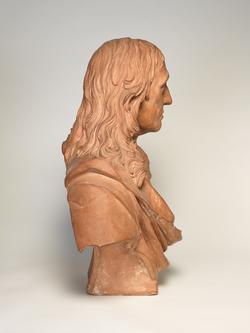Current Location: In storage
Titles
John Milton (1608-1674)
Maker(s)
Maker:
Rysbrack, John Michael
Entities
Categories
Description
Bust. Terracotta. The sitter is turned front, facing and looking slightly right. He is bare-headed, and his hair is falling long over the shoulders. He is clean-shaven. The sitter wears a doublet, with wide, falling-band collar, and drapery passing over the right shoulder, and under the left arm. The bust terminates in a low square base, inscribed on the front 'MILTON'.
Notes
History note: Formerly in the collection of Sir Edward Littleton, Bart., who bought it from Rysbrack for his new house, Teddesley Park, Staffordshire, 1757; it remained there until removed to London by Lord Hatherton, a collateral descendant, in 1931; exh. Messrs Spink's, London and bought through them from Lord Hatherton, 1932.
Legal notes
Bought with the Anne J. Pertz Fund
Measurements and weight
Height: 60 cm
Height: 23 1/2 in
Acquisition and important dates
Method of acquisition: Bought
(1932)
by
Hatherton, Lord
Dating
18th Century, second quarter
George II
Production date:
AD 1738
: dated 1738
Note
Based in London from 1720, Antwerp-born Rysbrack made several busts of Milton, the first in 1728 for the ‘Temple of British Worthies’ at Stowe House, Buckinghamshire. There is also a marble example in Westminster Abbey. This terracotta bust was made in 1738 for the architect William Benson (1682–1754), as the model for a subsequent version in marble. Rysbrack kept the terracotta and sold it in 1757 to Sir Edward Littleton. It was displayed in Littleton’s newly-built family seat, Teddesley Hall, Staffordshire, together with the bust of Alexander Pope (M.3-1932).
Milton was a famous 17th-century English poet, famed for his epic Paradise Lost (1667). His portrait was frequently included in sculpted groups of writers, commissioned by 18th-century English aristocrats in imitation of ancient Greek and Roman practice.
The design is based directly on the ad vivum engraving by William Faithorne of 1670.
People, subjects and objects depicted
Project
Materials used in production
Terracotta
Inscription or legends present
- Text: MILTON
- Location: On front of base
- Method of creation: Inscribed
Inscription present: signed and dated
- Text: Mich: Rysbrack/1738
- Location: At back
- Type: Signature
References and bibliographic entries
Identification numbers
Accession number: M.2-1932
Primary reference Number: 29741
External ID: CAM_CCF_M_2_1932
Stable URI
Audit data
Created: Saturday 6 August 2011
Updated: Monday 29 April 2024
Last processed: Tuesday 13 May 2025
Associated departments & institutions
Owner or interested party:
The Fitzwilliam Museum
Associated department:
Applied Arts

 IIIF Manifest
IIIF Manifest








